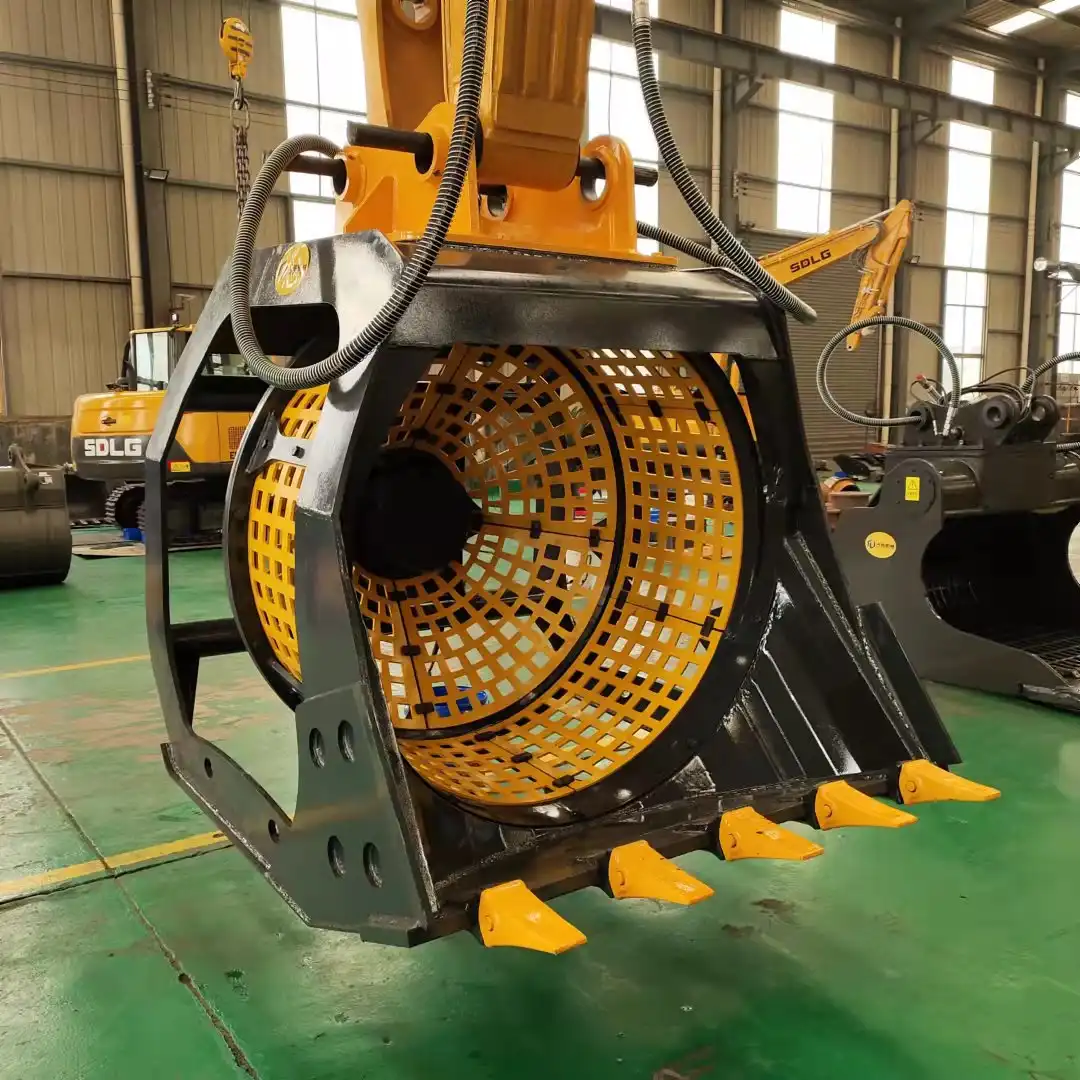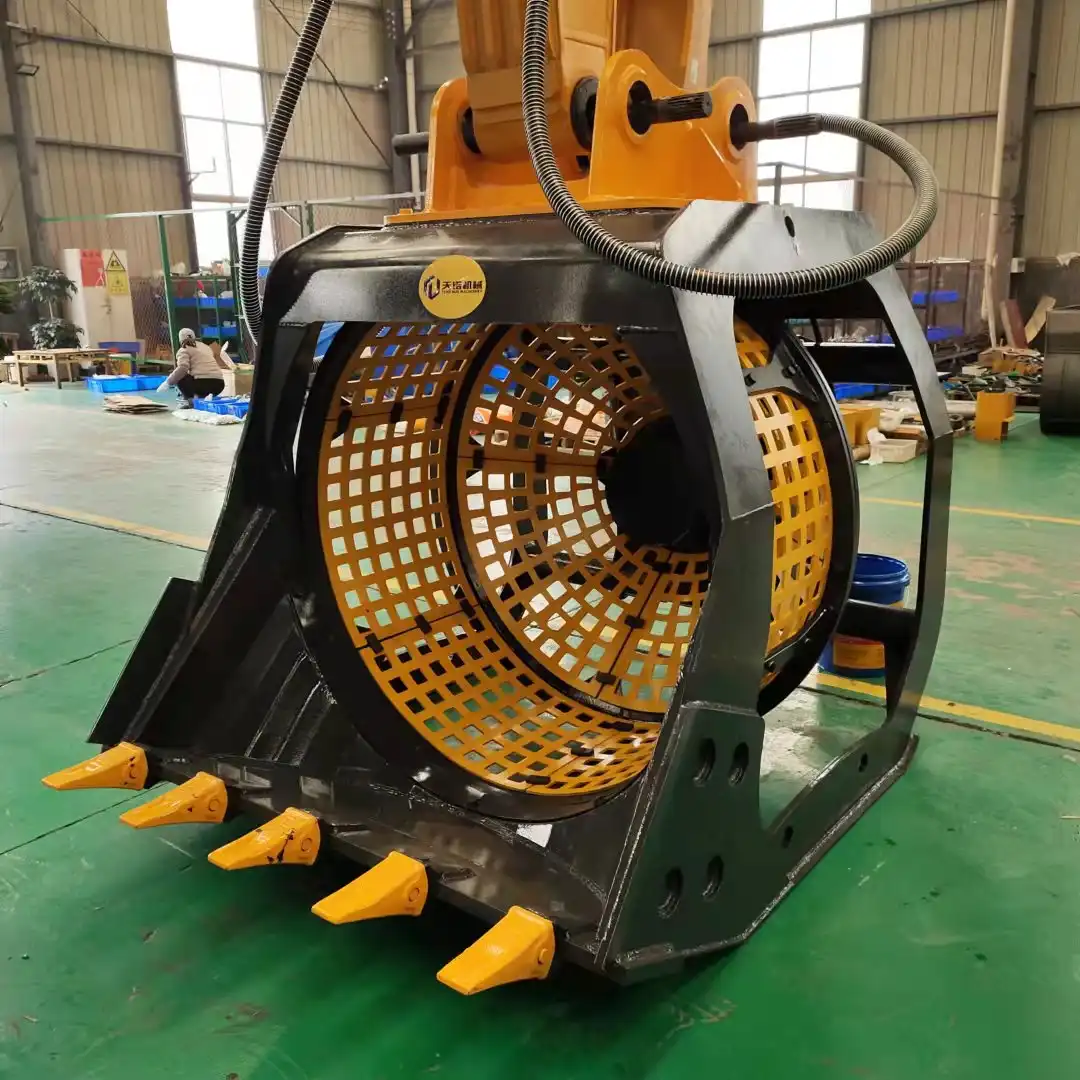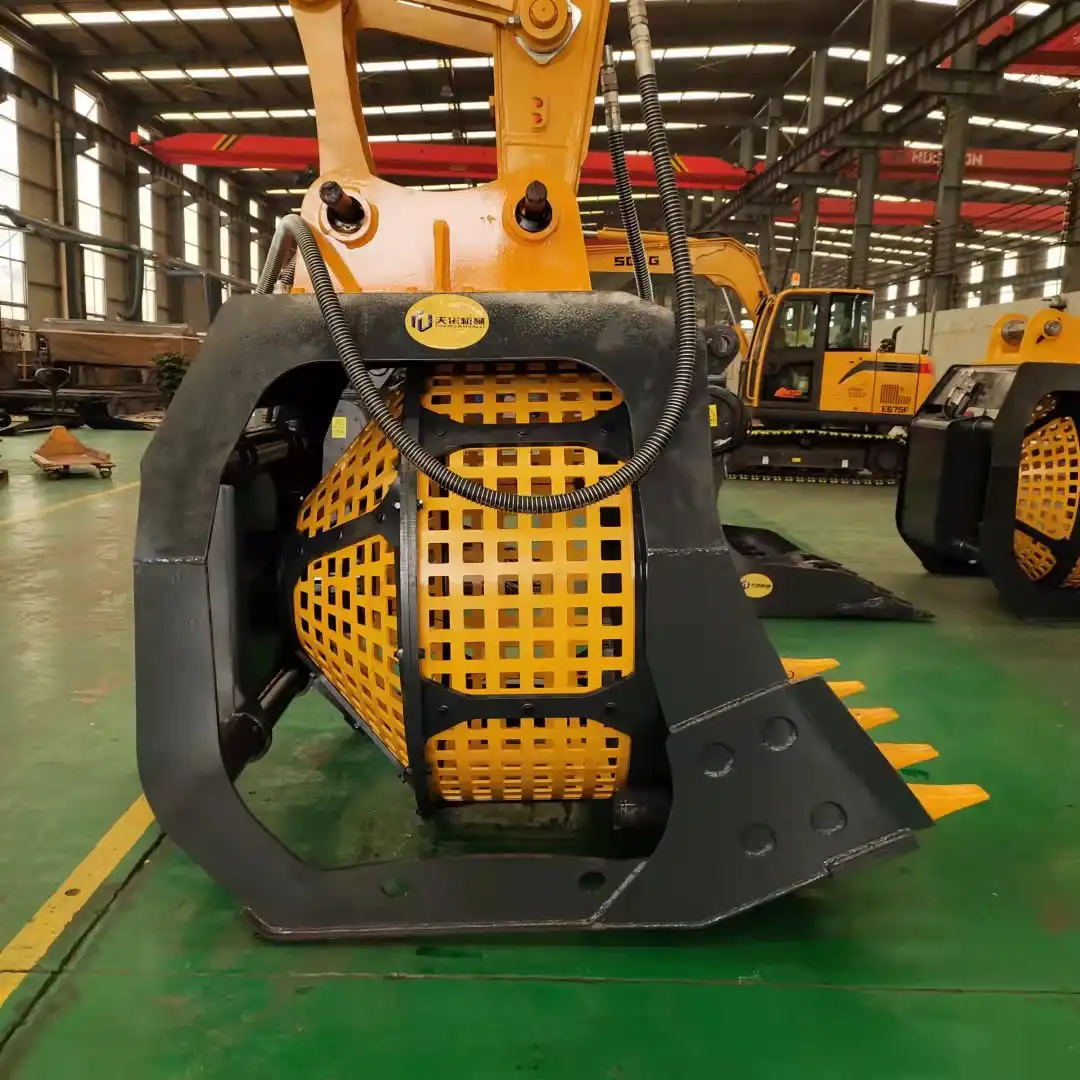Rotary Screening Bucket For Loader
Rotary screening buckets for loaders have revolutionized material processing in various industries. These innovative attachments offer unparalleled efficiency in sorting and separating materials on-site. By combining the functionality of a traditional loader bucket with a rotating screening mechanism, these tools enable operators to sift through soil, debris, and aggregates with precision and speed. The rotary action ensures thorough material separation, making it an indispensable asset for construction, landscaping, and recycling projects.
Loader Screening Buckets vs. Traditional Methods
Increased Efficiency: Rotary vs. Static Screening
When it comes to material processing, the battle between rotary and static screening methods is decisively won by rotary systems. Rotary screening buckets attached to loaders offer a dynamic approach to material separation that outperforms traditional static screens in several key areas. The continuous rotation of the drum ensures that materials are constantly in motion, preventing clogging and increasing the overall throughput of the screening process.
In contrast to static screens, which rely on vibration or manual agitation, rotary screens use gravity and centrifugal force to separate materials effectively. This mechanical action is particularly beneficial when dealing with damp or sticky substances that would typically cause issues for static screens. The result is a more consistent and reliable screening process, reducing downtime and increasing productivity on the job site.
On-Site Material Processing with Loader Screening Buckets
The ability to process materials directly on-site is a game-changer for many industries. Loader screening buckets bring the screening plant to the worksite, eliminating the need for separate stationary equipment. This on-site capability is particularly valuable in urban environments where space is at a premium, or in remote locations where transporting large machinery is challenging and costly.
By enabling immediate processing, these buckets allow for real-time quality control and adjustment of material grades. Operators can quickly assess the output and make necessary changes to the screening parameters, ensuring that the final product meets the required specifications without delay. This level of flexibility and responsiveness is simply not possible with traditional off-site processing methods.
Reducing Transportation Costs: The Loader Bucket Advantage
One of the most significant advantages of using rotary screening buckets on loaders is the substantial reduction in transportation costs. By processing materials on-site, companies can dramatically decrease the volume of material that needs to be transported to and from the worksite. This not only cuts down on fuel expenses but also reduces wear and tear on vehicles and roads.
Moreover, the ability to reuse screened materials immediately on-site contributes to a more sustainable operation. Excess soil or aggregates can be repurposed for backfilling or landscaping, minimizing waste and the need for additional material deliveries. This closed-loop system not only benefits the environment but also provides significant cost savings over time.

Versatility in Material Handling Applications
Screening Topsoil: From Landscaping to Large Gardens
Rotary screening buckets excel in topsoil processing, offering unparalleled versatility for landscaping projects of all sizes. These attachments can quickly separate rocks, roots, and debris from soil, creating high-quality, homogeneous topsoil ideal for gardening and landscaping applications. The ability to adjust screen sizes allows operators to produce different grades of soil on demand, catering to specific project requirements without the need for multiple specialized machines.
For large-scale garden developments, rotary screening buckets can process vast quantities of soil efficiently, ensuring consistent quality across extensive areas. This is particularly beneficial for commercial landscaping projects, where uniformity and quality control are paramount. The on-site screening capability also means that native soil can be improved and reused, reducing the need for imported topsoil and lowering overall project costs.
Mining Operations: Enhancing Productivity with Rotary Buckets
In mining operations, rotary screening buckets attached to loaders provide a mobile and efficient solution for material classification. These attachments can be used to screen ore, separate different grades of minerals, or remove overburden. The ability to perform these tasks on-site, close to the extraction point, streamlines the mining process and reduces the need for multiple handling stages.
For smaller mining operations or exploration sites, rotary screening buckets offer a cost-effective alternative to large, stationary screening plants. They provide the flexibility to process materials in varying quantities, adapting to fluctuating production demands without the need for significant infrastructure investments. This scalability makes them particularly valuable in the early stages of mine development or for short-term projects.

Cost-Effective Solutions for Construction Sites
ROI Analysis: Investing in Rotary Screening Buckets
Investing in rotary screening buckets for loaders presents a compelling return on investment (ROI) for construction companies. The initial cost of these attachments is quickly offset by the operational efficiencies and cost savings they provide. By eliminating the need for separate screening equipment and reducing material transportation, companies can see significant reductions in their operational expenses.
A comprehensive ROI analysis should consider factors such as increased productivity, reduced labor costs, and the value of recovered materials. For instance, a construction site that can reuse 50% of its excavated material through on-site screening could save substantially on disposal fees and new material purchases. Over time, these savings can amount to many times the initial investment in the screening bucket.
Reducing Labor Costs with Automated Screening Processes
Automated screening processes enabled by rotary buckets can significantly reduce labor costs on construction sites. Traditional manual screening methods are labor-intensive and time-consuming, often requiring multiple workers to operate effectively. In contrast, a single operator with a loader equipped with a rotary screening bucket can perform the same task more quickly and efficiently.
This automation not only reduces the number of workers required for material processing but also minimizes the risk of workplace injuries associated with manual screening. As a result, companies can reallocate their workforce to other critical tasks, improving overall site productivity and potentially reducing project timelines.
Maintenance Tips for Long-Lasting Loader Screening Buckets
To maximize the lifespan and performance of loader screening buckets, proper maintenance is crucial. Regular inspections should be conducted to check for wear on the screening mesh and rotating components. Keeping the bucket clean and free from material build-up after each use can prevent unnecessary strain on the mechanism and ensure consistent performance.
Lubrication of moving parts according to the manufacturer's recommendations is essential for smooth operation and longevity. It's also important to adhere to the specified weight limits and material types to avoid overloading or damaging the bucket. By following these maintenance practices, operators can ensure their rotary screening buckets remain a reliable and cost-effective tool for years to come.
Rotary screening buckets for loaders represent a significant leap forward in material processing technology. Their ability to enhance efficiency, reduce costs, and improve environmental sustainability makes them an invaluable asset across multiple industries. From construction and landscaping to waste management and mining, these versatile attachments offer solutions to many of the challenges faced in material handling and processing. As the demand for more efficient, cost-effective, and environmentally friendly operations continues to grow, rotary screening buckets are poised to play an increasingly important role in shaping the future of worksite productivity.

FAQ
①What types of materials can be processed with a rotary screening bucket?
Process a wide range of materials, including soil, sand, gravel, compost, demolition waste, and various aggregates. The versatility of these attachments makes them suitable for construction, landscaping, recycling, and mining applications.
②How does a rotary screening bucket compare to a traditional trommel screen?
While both serve similar purposes, screening buckets offer greater mobility and flexibility. They can be attached directly to loaders or excavators, allowing for on-site processing without the need for a separate, stationary screening plant. This makes them ideal for projects with space constraints or those requiring frequent relocation.
③Can the screen size be adjusted on a rotary screening bucket?
Yes, most screening buckets come with interchangeable screens of various sizes. This allows operators to adjust the screening mesh to suit different material sizes and project requirements, enhancing the attachment's versatility.
④What are the environmental benefits of using a rotary screening bucket?
Rotary screening buckets contribute to environmental sustainability by enabling on-site material recycling, reducing transportation emissions, and minimizing waste sent to landfills. They allow for the efficient reuse of materials, supporting circular economy principles in construction and landscaping projects.
⑤How does weather affect the performance of rotary screening buckets?
While screening buckets are generally less affected by weather than static screens, extremely wet conditions can impact performance, especially with fine materials. However, their design allows for better handling of damp materials compared to many traditional screening methods, making them a reliable choice in various weather conditions.
China Excavator Rotary Screening Bucket Supplier
TianNuo Machinery stands out as a leading manufacturer of excavator rotary screening buckets in China. With a comprehensive range of engineering solutions, including railway maintenance equipment and excavator modifications, TianNuo Machinery offers cutting-edge technology for various industries. Their screening buckets are designed for optimal performance, featuring customizable screen sizes and compatibility with excavators ranging from 6 to 40 tons. These attachments significantly enhance material recovery and management, reducing crushing time by up to 60%. For inquiries about their excavator specialized equipment, contact us at rich@stnd-machinery.com.
References
- Smith, J. (2023). "Advancements in Material Screening Technology for Construction," Construction Equipment Magazine, Vol. 45, No. 3, pp. 78-85.
- Johnson, A., & Brown, T. (2022). "Efficiency Analysis of On-Site Material Processing in Urban Construction Projects," Journal of Construction Engineering, Vol. 18, Issue 2, pp. 203-218.
- Lee, S. et al. (2023). "Innovative Approaches to Aggregate Screening in Mining Operations," Mining Technology Today, Vol. 7, No. 4, pp. 112-126.
- Garcia, M., & Wilson, R. (2022). "Sustainable Practices in Construction Waste Management: A Review," Environmental Science & Technology, Vol. 56, Issue 11, pp. 6789-6802.
- Thompson, K. (2023). "Material Recycling and the Circular Economy in Modern Construction," International Journal of Recycling, Vol. 12, No. 2, pp. 157-172.
- Anderson, P. (2023). "Market Trends in Loader Attachments: 2023 Analysis," Equipment World, Annual Industry Report, pp. 45-58.
About Author: Arm
Arm is a leading expert in the field of specialized construction and railway maintenance equipment, working at Tiannuo Company.

